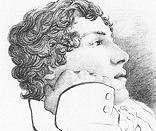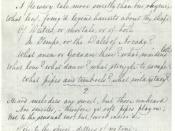Ode on a Grecian Urn
John Keats brilliantly uses poetic form and descriptive language in an attempt to evoke interest in an essentially uninteresting subject, as well as support a hidden agenda, with his poem, "Ode on a Grecian Urn". It is a delightfully reflective, lyrical poem, which contemplates the beauty of still art with the movement of life. By looking at the intricate poetic language Keats chooses for this ode we are allowed access to the enchanting images of the urn and also into the introspective mood of Keats himself. The three primary tools Keats uses are the title of the poem, diction conforming to rhyme scheme, and literary devices.
The title of the poem, "Ode on a Grecian Urn" seems at first simple and meaningless, but when analyzed at greater depth, sinister meaning becomes evident. Each word in the title has meaning. First, we see that he used the word "Ode" in the title, obviously stating the poetic form of his work.
The word "Ode" in the title is to make firm in the reader's mind that the poem will praise the urn as its primary function. The next word, "on", is an odd choice for the title. It would make more sense to use the word "to" (Ode to a Grecian Urn); Keats wanted to tie the title to the final two lines that the true ode (the poetry) is actually on the Grecian Urn. The third word, "a", serves an obvious meaning: to establish that there is only one of these Urns, perhaps cementing the uniqueness of the Urn. The fourth word comes as a surprise as well- why did he not simply use the adjective "Greek"? In the Webster's New World Dictionary, "Greek" is defined as "of ancient or modern Greece, its...


